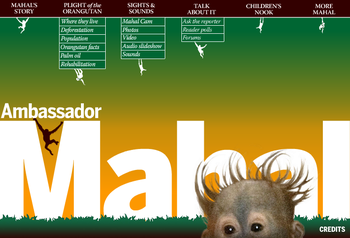Famed Milwaukee County Zoo orangutan’s death caused by strange infection

A team of researchers at the University of Wisconsin–Madison’s School of Veterinary Medicine has documented what caused the death of Mahal, the young orangutan who became a star of the Milwaukee County Zoo.
Photo courtesy of Milwaukee County Zoo
Mahal, the young orangutan who became a star of the Milwaukee County Zoo and an emblem of survival for a dwindling species, led an extraordinary life.
It turns out, the young ape died an extraordinary death, too.
Rejected by his biological mother at the Cheyenne Mountain Zoo in Colorado Springs, Colo., and eventually flown to Milwaukee aboard a private jet to live with a surrogate mother, Mahal became one of the Milwaukee County Zoo’s star attractions. His unexpected death at age 5 in late December 2012 was a shock to the community that came to know him through a popular newspaper feature series in the Milwaukee Journal Sentinel and a book that recounted his difficult start in life.

Tony Goldberg
Now, thanks to cutting-edge genetic diagnostics, a team of researchers led by Tony Goldberg at the University of Wisconsin–Madison’s School of Veterinary Medicine has documented the cause of Mahal’s death in the scientific literature, identifying a species of tapeworm unknown to science and newly recognized as a threat to primates.
“At the beginning, all we had were Mahal’s clinical condition and a tissue sample,” says Goldberg, professor in the Department of Pathobiological Sciences and associate director for research in the UW–Madison Global Health Institute. “We knew there was some type of infection in there. It could have been nearly anything. The list of potential agents was enormous.”
Goldberg, a veterinarian and expert in the identification of emerging and rare diseases in humans and other primates, worked with Annette Gendron of the UW–Madison Research Animal Resources Center, David O’Connor of the UW–Madison Department of Pathology and Laboratory Medicine, and veterinarians Roberta Wallace and Victoria Clyde from the Milwaukee County Zoo, as well as UW–Madison students and colleagues at the University of Florida, to identify the agent. The team pinned Mahal’s death on an unrecognized species of tapeworm in the genus Versteria. Their findings were published online in a recent (December, 2013) edition of the journal Emerging Infectious Diseases.
Mahal was the subject of a popular newspaper feature in the Milwaukee Journal Sentinel.
Tapeworms, notes Goldberg, are a large and diverse group of parasites. There are estimated to be more than 1,500 known species of the pathogenic flatworms, many of which are adapted to specific animal hosts. Of those, perhaps a few dozen can infect humans and other primates.
According to Goldberg, the tapeworm found in Mahal is an unknown species in the newly categorized Versteria genus, which has been found in weasels in either Africa or North America. Furthermore, Mahal’s tapeworm was in its larval form. “Larval tapeworms infect the tissues of animals,” says Goldberg. “This life stage is different from the adult form, which is the long, wormlike stage we usually think of.”
When certain tapeworm larvae in the tissues of an “intermediate” host are eaten by a predator, they grow into the more familiar adult form, which live in the intestine and produce eggs.
Sometimes, Goldberg explains, parasites like larval tapeworms infect animals they are not supposed to, as seems to be the case with Mahal. “It’s possible the parasite was expecting to be in a mouse but found itself inside an orangutan,” says Goldberg, noting that tapeworm eggs can move through the environment in complex ways. Mahal was therefore probably an “aberrant” host, and the larval form of the tapeworm infected practically every organ in his body.
“On hindsight, there was nothing that could have been done to prevent it by anyone at the zoo or anywhere else, and by the time the infection made Mahal sick it had already gotten out of control.”
Tony Goldberg
“For reasons we don’t understand, tapeworms sometimes go haywire,” Goldberg says, adding that how and when Mahal became infected remain mysteries. “It is possible he was infected a few weeks before he died. Or he may have been infected several years ago and the tapeworm was dormant and suddenly started to multiply out of control.”
To identify the culprit, Goldberg and his team used a technique known as “deep sequencing” to characterize all of the DNA in Mahal’s tissue samples. Ninety-seven percent of the genetic material, explains Goldberg, belonged to Mahal, of course. But because the orangutan genome is known and sequenced, Goldberg’s team was able to pick out DNA from the parasite.
The work, Goldberg says, was possible because of unique facilities at the Wisconsin National Primate Research Center AIDS Vaccine Research Laboratory.
What was left after the orangutan DNA was filtered out was a small percentage of DNA sequences roughly similar to Taenia solium, also known as the pork tapeworm, a parasite that afflicts humans. By doing additional genetic testing and comparing the results to banked DNA sequences of known tapeworm species, Goldberg and his group were able to place the tapeworm in the newly proposed genus Versteria.
“This was an unknown species and a very unusual presentation,” says Goldberg. “On hindsight, there was nothing that could have been done to prevent it by anyone at the zoo or anywhere else, and by the time the infection made Mahal sick it had already gotten out of control. This was an unfortunate quirk with very sad consequences.”


